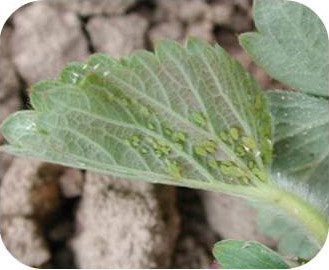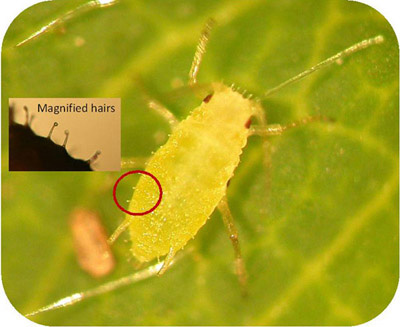Strawberry aphids and their management in strawberry farms
Learn about the strawberry aphid, how to identify it from other aphids and products to control it.
The strawberry aphid (Chaetospihon fragaefolii) is one of several aphid species that are found in strawberry fields. Sooty mould, which develops on the honeydew secreted by aphids, occasionally causes damage to leaves and fruit. More significantly, aphids can transmit viruses from one strawberry plant to another. The strawberry aphid is the main vector of several important strawberry virus diseases, including strawberry mottle (SMoV), strawberry vein banding (SVBV), strawberry mild yellow edge (SMYEV) and strawberry crinkle virus (SCV).
Strawberry aphids can be distinguished from other aphids by the presence of small hairs with knobbed ends all over their body. They are pale green to yellow in colour, and range in size from 0.8-1.1 mm for nymphs to 1.3-1.5 mm for adults. Adults have long antennae, as long as, or longer than their body. They prefer to feed on the underside of leaves, where they are usually found. Strawberry aphids can be winged or wingless. The winged forms (also known as alates) (Figure 3) move from field to field, travelling several km in light breezes.
To scout for strawberry aphids examine the underside of new leaves which have not yet uncurled (Figure 1) .

Figure 1: Aphids (species not determined) on new growth of strawberry plant.
If you see aphids, use a hand lens or microscope to confirm the presence of the knobbed hairs, which is characteristic of the strawberry aphid (Figure 2).

Figure 2: Strawberry aphid, identified by knobs on the end of each hair. (Photo credit: D. Moreau. AAFC)
It is important to control strawberry aphids to prevent the spread of viruses from one plant to another, and from older infected fields to new healthy plantings. Control is required season long. However the most critical time for control is in May and June when aphid populations peak and winged adults move from field to field.
There are several products for aphid control (Table 1). See OMAFRA Publication 360, Guide to Fruit Production and the product label for complete details.
- On overwintering strawberries, make the first application when new leaves are emerging with a systemic insecticide such as Admire/Alias or Cygon/Lagon. Both are very toxic to bees and should be used well before any bloom is present. At this timing, you can choose to apply Admire or Alias as a soil drench or Admire as a foliar spray. Follow up as necessary during bloom with foliar applications of Beleaf 50 SG. From green fruit to harvest, chose Assail or Beleaf. Do not use Assail or other group 4 products if you used Admire or Alias as a soil drench. Cygon or Lagon are a good choice for after renovation.
- On new plantings, you can hold off on aphid control until new leaves are emerging and aphids are present. An application of Admire or Alias applied to the soil should provide at least three weeks of protection. Follow up with foliar applications of Beleaf or Cygon/Lagon as needed. A second option is to start with a foliar application of Admire, and follow up with Beleaf, Assail, or Cygon/Lagon as needed.
- On day neutrals, a soil application of Admire is not recommended over plastic mulch. Your options are restricted to foliar applications of Beleaf or Assail. Because your options are limited you should wait to control aphids as long as possible, and begin when populations are high or at the first sign of winged aphid flight in the area. Fortunately we have not seen much virus in day neutral strawberries.
Monitoring for pests in strawberries is very important. Your aphid control strategy will have an impact on other pests and beneficial insects. Be sure you are scouting because typical pests may not appear and new ones may turn up! For example:
- Products such as Admire/Alias , Cygon/ Lagon applied for aphids may reduce or delay the need for strawberry clipper weevil and tarnished plant bug control.
- Beleaf is also registered for tarnished plant bug control, and may also help to suppress thrips. Beleaf is not registered thrips, and it is not clear if registered rates for aphids will be enough to control thrips. It is important to monitor pest activity before spraying additional insecticides.
- Admire /Alias will also suppress leafhoppers but have sometimes been associated with outbreaks of spider mites.
| Product active ingredient group | Rate | Comments | Preharvest interval (phi) Restricted Entry Interval (REI) | Maximum # applications/yr | Bee toxicity |
|---|---|---|---|---|---|
Admire 240 or Alias 240 SC imidacloprid Group 4 | Approx 1.2 L/ha but depends on row spacing. See label. | Apply in 2000 L water per ha over the row and wash into soil immediately with rain or irrigation. | 30 days phi 24 hours REI | 1 (soil application) | Highly toxic to bees. Apply well before buds show white or bloom is present. |
Admire 240 imidacloprid Group 4 | 175 mL/ha | Apply as a foliar spray. Do not use if Admire or Alias was applied previously as soil drench. | 7 days phi 24 hours REI | 2 (foliar applications) | Highly toxic to bees. Apply well before buds show white or bloom is present. |
Assail 70 WP acetamiprid Group 4 | 56-86 grams/ha | Apply as a foliar spray. Use the high rate under heavy pressure, and repeat application if necessary. Also controls tarnished plant bug, but at different rates. See label. Do not use if Admire or Alias was applied previously as soil drench. | 1 day phi 12 hours REI | 2 | Toxic to bees. Avoid application when bloom is present and bees are working |
Thionex 50 WSP endosulfan Group 2A | 2.0 kg/ha | Apply as a foliar spray. Evaluate control after application. Seems to provide short term control or suppression. | 12 days phi 12 days REI, except 7 days for certain tasks, see label. | 2 | Toxic to bees. Avoid application when bees are active. |
Cygon 480-Ag dimethoate Group 1B | 2.25 L/ha | Also controls tarnished plant bug but at different rates. See label. | 7 days phi No REI stated on label, default is 12 hours. | 2 | Highly toxic to bees |
Lagon 480 E dimethoate Group 1B | 2.25 L/ha | Also controls tarnished plant bug but at different rates. See label. | 7 days phi No REI stated on label, default is 12 hours. | 3 | Highly toxic to bees |
| Beleaf 50 SG flonicamid Group 9C | 120-160 grams/ha | Treated aphids stop feeding but do not die immediately. Also controls tarnished plant bug but at different rates. See label. Alternate with other products, such as Assail. | 0 days phi 12 hours REI | 3 | Relatively non-toxic to bees |